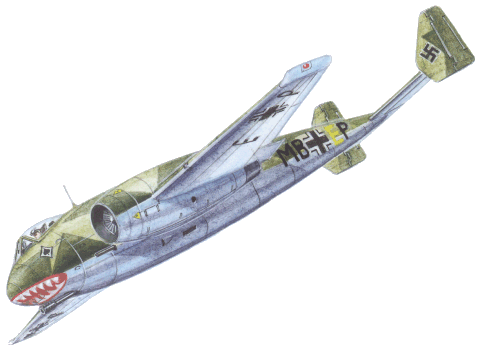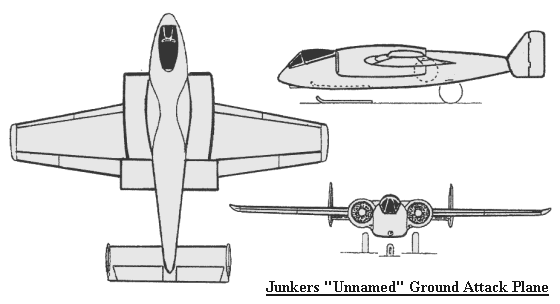| Span | Length | Height |
| 14.6 m 47' 10" |
11.85 m 38' 10" |
3.85 m 12' 9" |
| Manufacturer | Scale | Material | Notes |
| Unicraft | 1/72 | Resin | |

Above color illustrations from Geheimprojekte der Luftwaffe Band III - Schlachtflugzeuge und Kampfzerstörer 1935-1945
 In the middle of 1944, the Junkers aircraft
company worked on a project for a low-level ground attack aircraft to replace
the Henschel Hs 129 ground attack aircraft. The fuselage was stout
and tapered, and was armored throughout. Fuel was contained entirely
in the armored fuselage. The wings were straight and exhibited taper on both
the leading and trailing edges. A twin fin and rudder configuration was chosen
with the tailplanes being horizontal. The engines were to be two Daimler
Benz ZTL 109-007 double-bypass jet engines and were mounted in the wing
roots. These engines were designed to allow a considerable increase
in power but had a reduced fuel consumption and were designed by Prof. Dr.
-Ing. Karl Leist. As a consequence of the secondary compressed airflow
circuit, the intake and overall diameter of the engine was larger than the
BMW 003 or Jumo 004 jet engines. The main landing gear retracted sideways
into the fuselage, and the nose "gear" consisted of a retractable, pneumatically
sprung skid. Two men comprised the crew and they sat in a cockpit in the
aircraft's nose. Armament was to consist of one MK 103 30mm cannon in the
nose and two MG 151/20 20mm cannon in the lower wing roots.
In the middle of 1944, the Junkers aircraft
company worked on a project for a low-level ground attack aircraft to replace
the Henschel Hs 129 ground attack aircraft. The fuselage was stout
and tapered, and was armored throughout. Fuel was contained entirely
in the armored fuselage. The wings were straight and exhibited taper on both
the leading and trailing edges. A twin fin and rudder configuration was chosen
with the tailplanes being horizontal. The engines were to be two Daimler
Benz ZTL 109-007 double-bypass jet engines and were mounted in the wing
roots. These engines were designed to allow a considerable increase
in power but had a reduced fuel consumption and were designed by Prof. Dr.
-Ing. Karl Leist. As a consequence of the secondary compressed airflow
circuit, the intake and overall diameter of the engine was larger than the
BMW 003 or Jumo 004 jet engines. The main landing gear retracted sideways
into the fuselage, and the nose "gear" consisted of a retractable, pneumatically
sprung skid. Two men comprised the crew and they sat in a cockpit in the
aircraft's nose. Armament was to consist of one MK 103 30mm cannon in the
nose and two MG 151/20 20mm cannon in the lower wing roots.